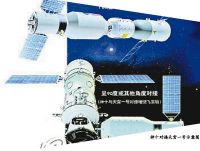Shenzhou 10
Shenzhou 10 (神舟10号), constituted of a propelling module, a return capsule and an orbital module, is the fifth manned space flight of China’s Shenzhou spacecraft series.
The manned space flight was launched on June 11, 2013. On June 13, astronauts of Shenzhou 10 spacecraft entered Tiangong 1, a target orbiter and space module.
The return capsule of Shenzhou 10 spacecraft landed at around 8:07 a.m. Beijing Time on June 26, 2013 at the main landing area in north China's Inner Mongolia Autonomous Region. Commander-in-chief of the country's manned space program Zhang Youxia announced that the Shenzhou 10 mission was successful.
The Shenzhou 10 space mission's astronauts said they "feel good" after they left the spacecraft's return module.
Shezhou 10 carried three astronauts for its mission. The number of crew members is the same as for its previous twin spacecraft Shenzhou 9, which carried two male taikonauts Jing Haipeng and Liu Wang, and the first female taikonaut Liu Yang.
Wang Yaping is the only female taikonaut in Shenzhou 10, according to the general engineer of China’s manned space program, Zhou Jianping.
Shenzhou 10’s mission is to improve the technologies of Shenzhou 9 in space docking.
With a height of 9 meters, a weight of 8 tons and a maximum diameter of 2.9 meters, Shenzhou 10 will fly at 28,440 kph and will take 90 minutes to circle around earth.
The space flight will spend 15 days in space and dock on Tiangong 1 on the 12th day, where astronauts will conduct space science experiments and offer lessons to students back on Earth. The space module entered the appropriate docking orbit at the end of May and is now running normally.
The mission, which symbolizes the maturity of Chinese technologies in space station operations, also paves the way for the country’s future manned space missions.
Shenzhou 10 was launched by the rocket Long March 2F at the Jiuquan Satellite Launch Center, located in Inner Mongolia, and returned on Jun.26, 2013.
